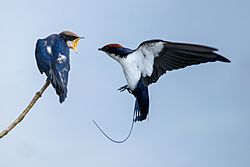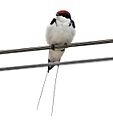Wire-tailed swallow facts for kids
Quick facts for kids Wire-tailed swallow |
|
|---|---|
 |
|
| Conservation status | |
| Scientific classification | |
| Genus: |
Hirundo
|
| Species: |
smithii
|
The wire-tailed swallow (Hirundo smithii) is a small, quick bird. It belongs to the swallow family. You might see it perching or flying fast.
There are two main types, called subspecies. One lives all over Africa. The other is found in southern and southeastern Asia. Most wire-tailed swallows stay in one place. But some from Pakistan and northern India fly south for winter. This is called migration.
The name Hirundo is a Latin word for swallow. The second part, smithii, honors a scientist named Christen Smith. He was a Norwegian botanist and geologist.
Contents
What Does a Wire-tailed Swallow Look Like?
The wire-tailed swallow is a small bird. It is about 18 cm (7.1 in) long. Its upper body is a bright blue color. Its belly is bright white. It also has a reddish-brown cap on its head.
Younger birds look a bit different. They do not have the long tail wires yet. Their caps are a dull brown, not reddish-brown. The bird gets its name from its very long outer tail feathers. These feathers look like two wires trailing behind it.
Both male and female swallows look alike. However, the female's "wires" are a bit shorter. Young birds have a brown head, back, and tail. The Asian type, H. s. filifera, is larger. It also has a longer tail than the African type, H. s. smithii.
Where Do Wire-tailed Swallows Live and What Do They Eat?
You can find these birds in open areas. They like to be near water and where people live. Wire-tailed swallows are very fast flyers. They mostly eat insects, especially flies. They catch their food while flying.
These swallows are often seen flying low over water. They are more connected to water than most other swallows.
Nesting and Reproduction
Wire-tailed swallows build neat, half-bowl-shaped nests. They use mud that they gather with their beaks. They place their nests on vertical surfaces. These are usually near water, like under cliff ledges. Today, they often build nests on human-made structures. These include buildings and bridges.
In Africa, a female swallow usually lays three to four eggs. In Asia, she can lay up to five eggs. Unlike many swallows, these birds nest alone. They also protect their nesting area. Other swallows often nest in large groups.
Types of Wire-tailed Swallows
The wire-tailed swallow is part of the Hirundo group. This group includes many types of "barn swallows" found worldwide. There are two main types, or subspecies, of the wire-tailed swallow:
- H. s. smithii: This type is also called the African wire-tailed swallow. It was first described in 1818. You can find it all over Africa.
- H. s. filifera: This type is known as the Asian wire-tailed swallow. It was first described in 1826. It lives in southern and southeastern Asia.
Gallery
-
H. s. smithii, Namibia
-
H. s. smithii in Kenya -
H. s. filifera at Pocharam lake, Andhra Pradesh, India









